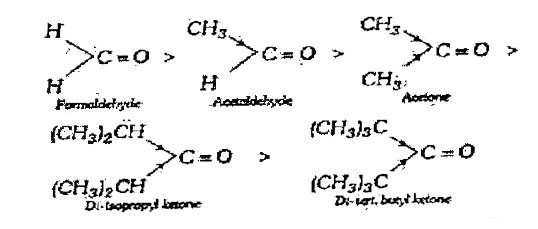Aldehyde are more reactive than ketone ?Explain why.
1. Inductive effect : The relative reactivities of aldehyde and ketone in nucleophilic addition reactions may be attributed to the amount of positive charge on the carbon atom. A greater positive charge means a higher reactivity. If the positive charge is dispersed throughout the molecule the carbonyl compound become more stable and its reactivity decrease. Now, alkyl group is an electron releasing group + I Inductive effect). Therefore, electron releasing power of two alkyl group in ketone is more than that of one in aldehyde. As a result, the electron deficiency carbon atom in the carbonyl group is satisfied more in ketone than in aldehyde. Therefore, the reduced positive charge on carbon in case of ketone discourage the attack of nucleophiles. Hence, electronically ketones are less reactive than aldehyde.

2. Steric effect: The size of the alkyl group is more than that of hydrogen. In aldehyde there is one alkyl group but in ketones, there are two alkyl groups attached to the carbonyl group. The alkyl groups are larger than a hydrogen atom and these cause hindrance to the attacking group. This is called steric hindrance. As the number and size of the alkyl groups increases, the hindrance to the attack of nucleophilc also increasc and Reactivity decrease. The lack of hindrance for nucleophile to attack is another reason for the greater reactivity of formaldehyde. Thus, the reactivity follows the order:

Topper's Solved these Questions
- ALDEHYDES ,KETONES AND CARBOOXALIC ACIDSBOOK - ACCURATE PUBLICATIONCHAPTER - ALDEHYDES ,KETONES AND CARBOOXALIC ACIDSEXERCISE - DISTINGUISH TEST
5 Videos
- ALDEHYDES ,KETONES AND CARBOOXALIC ACIDSBOOK - ACCURATE PUBLICATIONCHAPTER - ALDEHYDES ,KETONES AND CARBOOXALIC ACIDSEXERCISE - CARBOXYLIC ACID (1 MARK QUESTIONS )
20 Videos
- ALCOHOL, PHENOL AND ETHERBOOK - ACCURATE PUBLICATIONCHAPTER - ALCOHOL, PHENOL AND ETHEREXERCISE - ETHERS
16 Videos
- BIOMOLECULESBOOK - ACCURATE PUBLICATIONCHAPTER - BIOMOLECULESEXERCISE - 2 MARK QUESTIONS
29 Videos
Similar Questions
Why aldehydes are more reactive than ketones ?
View SolutionGive reason : Aldehydes are more reactive than ketones towards nucleophilic reagents.
View SolutionHow would you account for the following :
(i) Aldehydes are more reactive than ketones towards nucleophiles.
(ii) The boiling points of aldehydes and ketones are lower than those of corresponding acids.
(iii) Aldehydes and ketones undergo a number of addition reactions.
View SolutionExplain why aldehydes are more reactios than ketones.
View SolutionExplain why aldehydes are more reactive than ketones.
View SolutionWhy are alkenes more reactive than alkanes ?
View SolutionSTATEMENT -1: Aldehydes are more Reactive then corresponding ketone for Nucleophillic reactions
STATEMENT -2: Due to electron density at functional group carbon which is higher in ketone than in Aldehyde.
View SolutionOxidation of aldehydes is easier than that of ketones. Explain.
View SolutionOxidation of aldehydes is easier than that of ketones. Explain.
View SolutionWhy are aldehydes more reavtice than ketones towards nucleophilic addition reactions ?
View Solution
